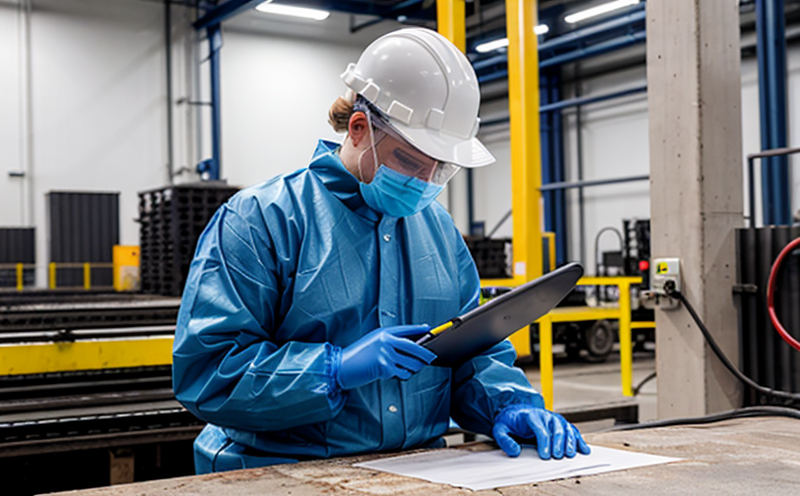ISO 9886 Physiological Testing of Heat Stress in Manufacturing
The ISO 9886 standard provides a framework for conducting physiological testing to evaluate heat stress conditions in industrial manufacturing environments. This service is critical for ensuring the health and safety of employees working under high-temperature conditions, which are prevalent in many sectors such as automotive, electronics, textiles, and food processing.
The primary goal of this service is to measure biological parameters that can indicate the physiological strain experienced by workers due to heat stress. These parameters include body temperature, heart rate, core temperature, hydration levels, and sweat loss. By accurately measuring these variables, the testing process provides actionable insights into the adequacy of current heat stress management practices.
The service is particularly beneficial for companies that need to comply with occupational health and safety regulations or improve worker comfort and productivity in hot environments. It can be used to assess the effectiveness of cooling systems, personal protective equipment (PPE), work schedules, and other interventions aimed at reducing heat stress.
A key aspect of this service is the use of advanced physiological measurement devices, such as wearable sensors and thermometers, which allow for continuous monitoring during prolonged periods of exposure. The data collected can be used to refine heat stress policies and improve worker safety protocols.
Our team of experts will work closely with your organization to design a comprehensive testing plan that aligns with your specific needs and industry standards. This may include selecting appropriate test subjects, establishing baseline measurements, and determining the duration and frequency of tests based on prevailing conditions in your manufacturing environment.
The results of this testing can be used to identify critical thresholds for heat stress risk, which can then inform the development of targeted interventions. For example, if the data indicates that certain tasks are particularly stressful under specific environmental conditions, adjustments could be made to work processes or PPE design. This proactive approach not only enhances worker safety but also reduces the likelihood of heat-related illnesses and associated costs.
It is important to note that ISO 9886 testing should be conducted by trained professionals who understand both the technical aspects of physiological measurement and the broader implications for occupational health and safety. Our team has extensive experience in this area, ensuring that all tests are performed accurately and consistently with international standards.
Applied Standards
The ISO 9886 standard is applied to ensure consistency and reliability in physiological testing of heat stress in manufacturing environments. This standard provides a clear framework for conducting these tests, which includes specific procedures for data collection, analysis, and reporting.
- Data Collection: The standard specifies the types of biological parameters that should be measured during testing. These include body temperature, heart rate, core temperature, hydration levels, and sweat loss.
- Testing Environment: Testing must be conducted in controlled environments that mimic real-world conditions as closely as possible. This ensures that the results are relevant to actual work scenarios.
- Data Analysis: The standard provides guidelines for analyzing the collected data, including statistical methods and criteria for determining heat stress risk levels.
The use of ISO 9886 ensures that all tests conducted by our laboratory meet internationally recognized standards, providing confidence in the reliability and accuracy of the results. This is particularly important when comparing test results across different facilities or over time within a single facility.
Scope and Methodology
| Parameter | Description |
|---|---|
| Body Temperature | The measurement of skin temperature using infrared thermometers or internal probes. |
| Heart Rate | Determined using heart rate monitors placed on the chest. |
| Core Temperature | Measured via ingestible capsules that transmit data to a receiver worn by the subject. |
| Sweat Loss | Quantified through direct measurement of fluid loss during testing. |
| Hydration Levels | Assessed using urine osmolality tests and blood glucose levels. |
The methodology for ISO 9886 physiological testing involves several key steps. First, the test subjects are selected based on their job roles and expected exposure to heat stress. Once selected, they undergo baseline measurements of all relevant parameters before initiating the testing process. During the testing period, continuous monitoring is conducted using wearable sensors and other suitable devices.
At the conclusion of the test period, all data collected is analyzed according to ISO 9886 guidelines. This includes calculating heat stress indices such as Wet Bulb Globe Temperature (WBGT) and Core Body Temperature Difference (CBTD). Based on these calculations, risk levels are determined and recommendations for improvement are provided.
The testing process is designed to be rigorous and comprehensive, ensuring that all relevant factors contributing to heat stress are accounted for. This includes not only environmental conditions but also individual physiological responses. By following this standardized methodology, our laboratory can provide accurate and reliable data that can inform evidence-based decisions regarding heat stress management in manufacturing environments.
Quality and Reliability Assurance
- Data Accuracy: Our team employs state-of-the-art instruments and software to ensure precise measurement of all relevant parameters. Regular calibration checks are performed to maintain instrument accuracy.
- Standard Operating Procedures: All testing follows strict protocols outlined in ISO 9886, ensuring consistency across tests conducted at different times or by different personnel.
- Data Validation: The collected data is cross-verified using multiple methods and compared against historical data to ensure reliability. Any discrepancies are investigated thoroughly.
- Expert Review: All test results undergo review by our team of experts, who have extensive experience in occupational health and safety testing.
The quality and reliability of the testing process is paramount for ensuring accurate assessment of heat stress conditions. By adhering to these rigorous standards, we can provide clients with confidence that their data reflects real-world scenarios accurately. This ensures that any interventions recommended are based on solid evidence rather than assumptions or incomplete information.





